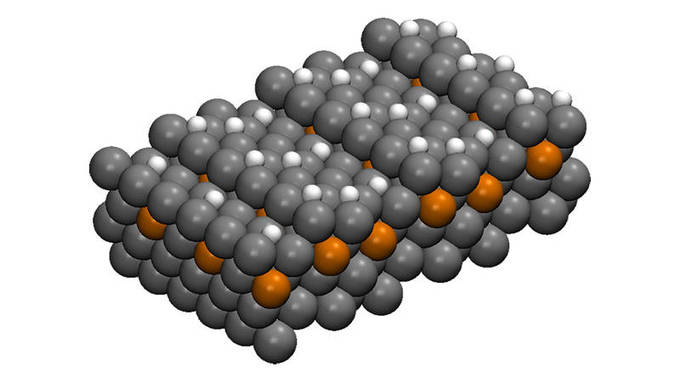Effizienz der Wasser-Elektrolyse verdoppelt
Kupferschicht unter der Oberfläche steigert Aktivität von Platin-Elektroden
2016-03-10 – Nachrichten aus dem Physik-Department

Noch müssen bei Stromüberschuss Windräder vom Netz genommen werden. Als Alternative wird immer wieder die Spaltung von Wasser in Wasserstoff und Sauerstoff genannt, die mit der überschüssigen Energie betrieben werden könnte. Doch bisher wird Wasserstoff industriell vor allem aus Erdgas hergestellt. Ein Prozess, bei dem zwar große Mengen des Treibhausgases Kohlendioxid freigesetzt werden, der jedoch immer noch billiger ist als die Wasser-Elektrolyse.
Die Elektroden für die Wasser-Elektrolyse enthalten üblicherweise Platin als Katalysator, um die Umsetzung von Wasser zu Wasserstoff und Sauerstoff zu beschleunigen. Damit die Reaktion möglichst effizient abläuft, dürfen Zwischenprodukte dabei weder zu stark noch zu schwach an der Katalysatoroberfläche haften.
Herkömmliche Elektroden binden Zwischenprodukte zu stark
Das Team um Prof. Dr. Aliaksandr Bandarenka vom Lehrstuhl für Physik der Energieumwandlung und -speicherung der TU München und Prof. Dr. Wolfgang Schuhmann vom Bochumer Zentrum für Elektrochemie berechnete nun, wie stark die Zwischenprodukte an den Elektroden haften sollten, um eine möglichst effiziente Reaktion zu erlauben. Die Analyse ergab, dass herkömmlichen Elektroden aus Platin, Rhodium und Palladium die Zwischenprodukte etwas zu stark binden.
Die Forscher modifizierten daher die Eigenschaften der Platin-Katalysatoroberfläche, indem sie eine Schicht aus Kupferatomen einfügten. Mit dieser Zusatzschicht erzeugte das System doppelt so viel Wasserstoff wie mit einer reinen Platinelektrode. Allerdings nur, wenn die Forscher die Kupferschicht direkt unter der obersten Lage der Platinatome einbrachten. Die Gruppe beobachtete zudem, dass die Elektroden mit der Kupferschicht langlebiger waren, zum Beispiel widerstandsfähiger gegen Korrosion.
Wasser-Elektrolyse könnte mit überschussstrom betrieben werden
Nur vier Prozent des weltweit produzierten Wasserstoffs entstehen bislang durch die Elektrolyse von Wasser. Weil die verwendeten Elektroden nicht effizient genug sind, lohnt sich eine großflächige Anwendung nicht. „Bisher wird Wasserstoff überwiegend aus fossilen Brennstoffen gewonnen, wobei eine hohe Menge CO2 freigesetzt wird“, sagt Wolfgang Schuhmann. „Es wäre ein großer Schritt in Richtung klimaschonender Energieumwandlung, wenn wir Wasserstoff stattdessen mittels Elektrolyse gewinnen würden. Dafür könnten wir den Überschussstrom zum Beispiel aus der Windkraft nutzen.“
„Darüber hinaus ermöglicht uns die Forschung an dieser Reaktion zu testen, wie gut wir Katalysatoroberflächen designen können, indem wir unterschiedliche Metallatome präzise positionieren,“ ergänzt Aliaksandr Bandarenka. „Dieses Wissen könnte auch vielen anderen katalytischen Prozessen zugute kommen.“Die Deutsche Forschungsgemeinschaft förderte die Arbeiten im Rahmen der Exzellenzcluster RESOLV und Nanosystems Initiative Munich (NIM). Weitere Unterstützung kam von der Helmholtz-Energie-Allianz „Stationäre elektrochemische Speicher und Wandler“.
- Redaktion:
- Julia Weiler (RUB) / Andreas Battenberg (TUM) / Dr. Johannes Wiedersich (Physik-Department)
Veröffentlichung
Verwandte Meldungen
Links
Kontakt
- Prof. Dr. Aliaksandr S. Bandarenka
- Technische Universität MünchenJames-Franck-Str. 185748 GarchingTel.: +49 89 289-12531E-Mail: bandarenka@ph.tum.de